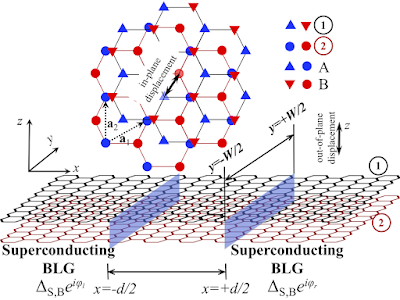Josephson effect in graphene bilayers with adjustable relative displacement
Mohammad Alidoust, Antti-Pekka Jauho, and Jaakko Akola
Phys. Rev. Res. (Rapid Comm.) 2, 032074 (2020). [PDF]The Josephson current is investigated in a superconducting graphene bilayer where the pristine graphene sheets can make in-plane or out-of-plane displacements with respect to each other. The superconductivity can be of intrinsic nature, or due to a proximity effect. The results demonstrate that the supercurrent responds qualitatively differently to relative displacement if the superconductivity is due to either intralayer or interlayer spin-singlet electron-electron pairing, thus providing a tool to distinguish between the two mechanisms. Specifically, both the AA and AB stacking orders are studied with antiferromagnetic spin alignment. For the AA stacking order with intralayer and on-site pairing no current reversal is found. In contrast, the supercurrent may switch its direction as a function of the in-plane displacement and out-of-plane interlayer coupling for the cases of AA ordering with interlayer pairing and AB ordering with either intralayer or interlayer pairing. In addition to sign reversal, the Josephson signal displays many characteristic fingerprints which derive directly from the pairing mechanism. Thus, measurements of the Josephson current as a function of the graphene bilayer displacement open up means for achieving a deeper insight of the superconducting pairing mechanism.
